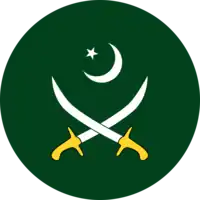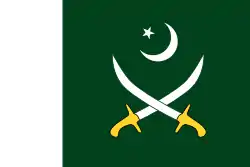Northern Light Infantry
The Northern Light Infantry (NLI) is a light infantry regiment in the Pakistan Army, based and currently headquartered in Gilgit, the capital of Gilgit–Baltistan. Along with other Pakistani military forces present in the Northern Areas (a part of Pakistan-administered Kashmir), the NLI has the primary responsibility of conducting ground operations in the interest of protecting the strategically important region of Pakistan. The regiment draws a majority of its recruits from native tribes present in the nearby mountainous areas and therefore they are less prone to altitude sickness and cold temperatures that characterize high-altitude mountain warfare, allowing the regiment to conduct its duties optimally.[1]
| Northern Light Infantry | |
|---|---|
 Regimental cap badge of the NLI. | |
| Active | 1999–present (This militia was raised by British Indian Army in 1889 as the Gilgit Levies to operate in the princely state of Jammu and Kashmir, and since then it has undergone many changes. It continued to function as a Pakistani paramilitary force until 1999, when it was given the status of a regular regiment in the Pakistani military after the Kargil War.) |
| Country | |
| Branch | |
| Type | Light infantry |
| Role | Mountain warfare |
| Size | 16 battalions |
| Headquarters | Gilgit, Pakistan |
| Colours | Green, white, sky blue |
| Engagements | |
| Commanders | |
| Chief of Army Staff | |
| Colonel Commandant | |
The Northern Light Infantry is best known for the extensive assistance and training it provided to the Afghan mujahideen (with backing from the CIA and ISI) during the Soviet-Afghan War.[2]
Formation
The Northern Light Infantry has its origins in the Gilgit Scouts raised by British India in 1913 for defending the princely state of Jammu and Kashmir's northern frontier. The Gilgit Scouts, along with rebels in the Jammu and Kashmir State Forces, fought in the northern front of the Indo-Pakistani War of 1947-1948, conquering important points of interest such as Skardu, Kargil and Batalik (the latter two were captured by the Indian Army in subsequent operations). In 1949, the Gilgit Scouts were split into two forces, with the wing under the original name now designated for internal security operations. The second wing, named the Northern Scouts, were designated for major external operations. In 1964, the Northern Scouts were further bifurcated with the raising of the Karakoram Scouts based in Skardu. All three forces were brought together again in 1975, under the banner of the Northern Light Infantry (a Pakistani paramilitary force). Following the events of the Kargil War with India, the Northern Light Infantry was altered from a functioning paramilitary to a fully operational regular regiment of the Pakistan Army.[3][4][5]
A new paramilitary force was created in 2003 under the name Gilgit Baltistan Scouts to fill the role of the former Gilgit Scouts.[4]
Status and composition
Upon its founding, the Northern Light Infantry regiment was to function as a paramilitary force, at par with the Pakistan Rangers and Frontier Corps, under the jurisdiction of the Ministry of Interior and commanded by regular Pakistan Army officers. In 1967 and 1970, two battalions of the NLI were airlifted and deployed to Karachi, Sindh for internal security duties such as riot control and aiding civil authorities during an election-related period of violence. The regiment's performance during this time earned them a commendation from Field Marshal Ayub Khan.
By 1998, the NLI consisted of 20 battalions commanded by a Major-General of the Pakistan Army under the designation of Inspector-General of the NLI, whose office was the Inspectorate General of NLI reporting to the GOC, X Corps as well as the Pakistani Interior Minister.
Notable operations
Soviet-Afghan War (1979–1989)
Following the Soviet Union's invasion of Afghanistan in 1979, the United States, United Kingdom, Pakistan and Israel launched Operation Cyclone, in which they financed and armed the Afghan mujahideen to prevent Afghanistan from becoming a Soviet satellite state and subsequently threaten Pakistan (a U.S. ally in the Cold War). Here, with primarily Saudi Arabian and American financing, the Northern Light Infantry trained Afghan mujahideen fighters in Gilgit-Baltistan before sending them back to Afghanistan with state-of-the-art armaments to fight the Soviet Army.
Siachen Glacier Conflict (1984–2003)
India's seizure of the Siachen Glacier (an area of Kashmir that was uninhabited and not controlled by any parties to the Kashmir conflict) in 1984 resulted in the renewal of high-level tensions with Pakistan until a mutual ceasefire agreement was brought into effect in 2003. During this period of intermittent fighting in the Siachen conflict, the NLI's 1st battalion performed defence and support work.[1][6]
Kargil War (1999)
In response to India's offensive operation and subsequent seizure of the entire Siachen Glacier, Pakistan began operations to occupy key Indian forward posts along the Line of Control (LoC), sparking the Kargil War. It was reported that the Pakistan Army had launched forces exclusively from the Northern Light Infantry during this conflict. These included the 5th, 6th, 8th and 12th battalions in full strength and some elements of the 3rd, 4th, 7th and 11th battalions with the paramilitary Chitral and Bajaur Scouts deployed for logistical support.[1]
Due to their inclination to the surrounding environment and regular training, troops of the Northern Light Infantry are generally less prone to the altitude sickness and cold temperatures that accompany mountain warfare. For this reason, they were chosen as the bulk force against the Indian Army in Kargil. Small infantry units belonging to the Northern Light Infantry slipped past Indian fortifications along the LoC and promptly assaulted strategic high security points. After taking control, they used these important points to maintain their position and repel any incoming Indian troops.[1] Heavy diplomatic pressure from the United States coupled with a massive Indian counterattack forced Pakistan to begin a withdrawal after months of intense fighting. Casualties during this conflict, like those of other Indo-Pakistani conflicts, remain disputed and unconfirmed. International sources (such as those from the U.S. Department of Defense) place Indian casualties at around 527+ whereas casualties for the Pakistani side numbered at around 700+.[7][8][9][10][11]
Following the end of the fighting, the Northern Light Infantry was commended for successfully taking control of Indian positions across the LoC and holding out against multiple elements of the Indian Army. In recognition of their performance in the Kargil conflict, the entire regiment was amalgamated into the Infantry Corps of the Pakistan Army with the status of a regular infantry regiment, and awarded with the Presidential Colours. After this, the NLI ceased to function as a paramilitary force and began anew as a regular infantry regiment in the Pakistan Army.[1]
References
![]() This article incorporates public domain material from the Library of Congress Country Studies website http://lcweb2.loc.gov/frd/cs/.
This article incorporates public domain material from the Library of Congress Country Studies website http://lcweb2.loc.gov/frd/cs/.
- "Northern Light Infantry". Global Security. Retrieved 17 January 2018.
- Murphy, Eamon (2013), The Making of Terrorism in Pakistan: Historical and Social Roots of Extremism, Routledge, pp. 127–, ISBN 978-0-415-56526-4
- Northern Light Infantry Regiment (NLI) Archived 2018-03-25 at the Wayback Machine, Pakistan Army, retrieved 25 March 2018.
- History of Gilgit Baltistan Scouts, Gilgit Baltistan Scouts, retrieved 6 April 2018.
- Snedden, Christopher (2015), Understanding Kashmir and Kashmiris, Oxford University Press, p. 255, ISBN 978-1-84904-342-7
- "Northern Light Infantry". Pakistan Army Website. Archived from the original on 1 July 2018. Retrieved 20 June 2017.
- Khan, M. Ilyas (2019-07-26). "The forgotten victims of the world's highest war". BBC News. Retrieved 2020-08-03.
- Tavares, Rodrigo (2006). Understanding Regional Peace and Security. Göteborg University. p. 297. ISBN 978-9187380679.
the US State Department quoted the Pakistani military casualties at 700, whereas Indian sources reported the Pakistani casualties to be 1000+. According to the then PM Nawaz Sharif (quoted in Gulf News, February 2002), the entire Northern Light Infantry of Pakistan was wiped out during the conflict claiming 2,700 lives.
- Chakraborty, A. K. "Kargil War Brings into Sharp Focus India's Commitment to Peace". Press Information Bureau, Government of India. Retrieved 23 May 2014.
- "Breakdown of casualties into Officers, JCOs, and Other Ranks". Parliament of India Website. Archived from the original on 2 December 2008. Retrieved 20 May 2009.
- "Complete Roll of Honour of Indian Army's Killed in Action during Op Vijay". Indian Army. Archived from the original on 22 December 2007. Retrieved 20 May 2009.
Further reading
- "Northern Light Infantry". Globalsecurity.org. Archived from the original on 4 March 2016.

